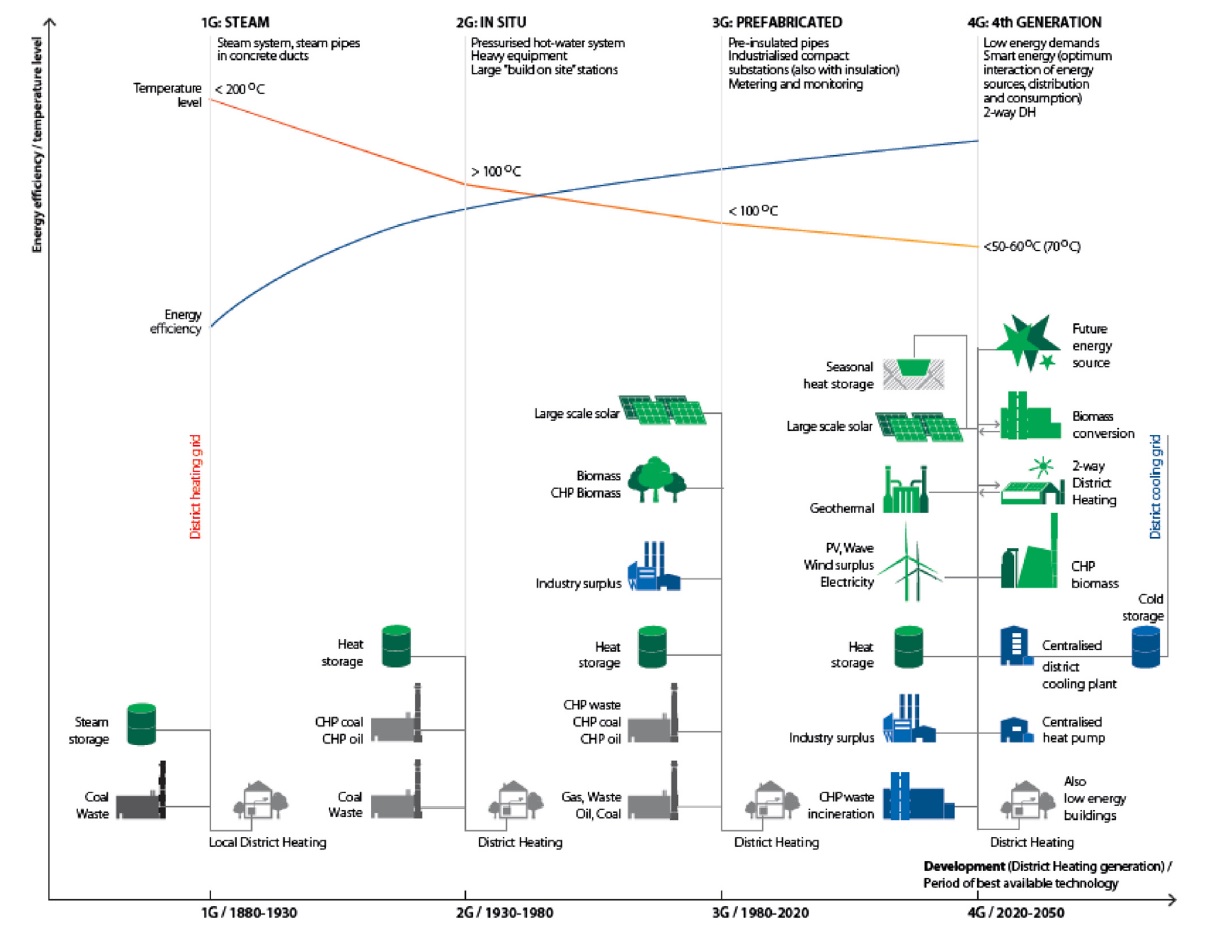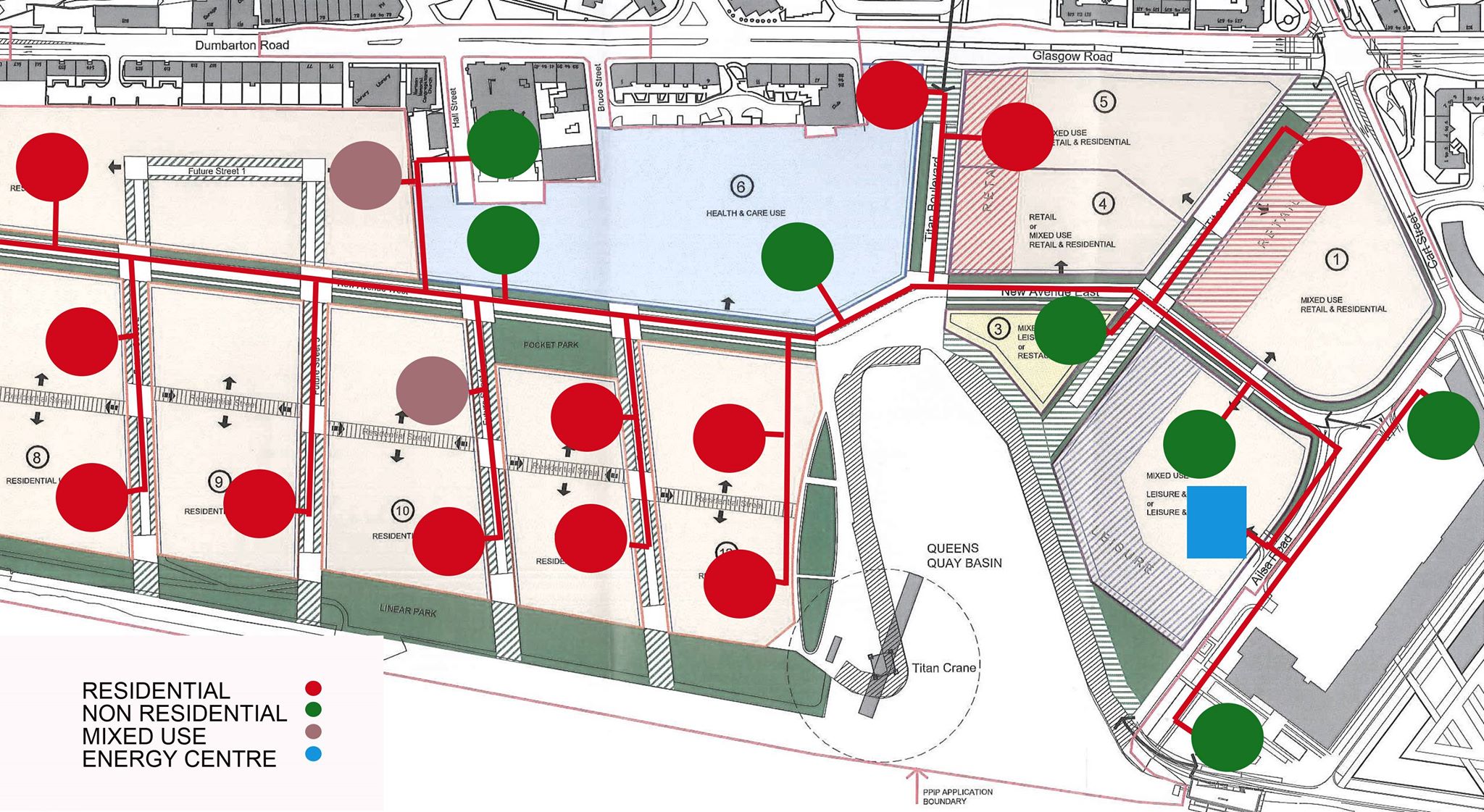District Heating
The concept of district heating (DH) was introduced in the 1880s. These systems heated water in coal powered boilers using steam as the heat carrier through the network. The second generation (2G) DH uses pressurised water at around 100°C as the heat medium. This technology was widely used in the former USSR. Nowadays, most commonly used DH is third generation (3G) with water temperatures ranging between 90 and 60 degrees[1]. Gas or biomass boilers are usually used for heating the water, and combined heat and power (CHP) systems are frequently incorporated to generate electricity alongside heat. All these ‘generations’ are classified as high temperature district heating (HTDH).
Prompted by the need for a solution to the challenge of climate change, the newest, fourth generation (4G) DH systems, aim to reduce the losses from the network and incorporate the use of renewable energy in the system. To achieve both of these the supply temperature needs to be lowered and the system needs to be developed further. Figure below represents the evolution of DH networks and demonstrates how the efficiency of the systems and components has changed. In context of 4GDH we talk about low temperature district heating (LTDH) with supply temperatures close to 55°C. 50°C is the lowest possible supply temperature to satisfy the requirement for the temperature of the domestic hot water (45°C). To avoid a risk of spreading of legionella, the systems in houses are separated from the main DH circuit. 4GDH is pioneered by Scandinavian countries, especially with Denmark leading the research.
The concept of district heating (DH) was introduced in the 1880s. These systems heated water in coal powered boilers using steam as the heat carrier through the netw
District Heating Evolution Schematic Diagram [i]
Initially the idea of DH was introduced to reduce the number of personal boilers and reduce the risk of boiler explosions in cities while increasing the comfort of residents. Since then the technology and reasons for use have changed. The main benefits of DH networks today are the centralised maintenance, possibility of use of waste heat, as well as the possibility of incorporation of renewable generation. The share of the DH covering the entire European heat demand could increase to 50% by the year 2050[2] - currently DH networks meet 13% of the European heat demand[3].
Building Systems
Since the temperatures of 3GDH are above 55°C there is no major risk of the Legionella bacterium, responsible for Legionnaires Disease, spreading. Therefore there is no need for special equipment or circuit separation. This is not a case for the 4GDH. The supply temperature to the network is close to 55°C and the return temperature only 30°C. This means that the dwelling/building circuit need to be decentralised from the main network by hydraulic circuit separation in the form of a flatstation (highly efficient heat exchanger)[4], [5]. For the hot water (HW) supply instantaneous heat exchanger units (IHU) are used in order to heat up fresh cold water when taping occurs [6]. Due to the low supply temperature for the space heating (SH) system, panel heating or a floor heating may be suggested since these technologies efficiently operates with supply temperatures below 50°C. These are suggested with account for heat losses through the piping network[7].
Designing the network
The heat loads (heat consumers) are aggregated into clusters for simplier initial calculations. The heat losses through the piping can be estimated based on the simplified layout of the network, peak loads for the DH network and industrial piping sheets which are available for use on pipe's manufacturer's websites. Design guidelines for the pressure drop through the pipelines exists in the building standards[8]. It must be noted that not all single peaks occur at the same time, therefore when choosing the “peak” values for the DH a careful selection should be made and diversification factor should be taken onto account to smoother the demand in order not to oversize the system as that leads to additional losses and malfunctioning of the system.
Case Study
The core of the whole Queens Quay development is the DH system, which should have enough capacity to provide space heating and hot water to supply both the residential buildings and commercial premises on the site. The DH network was designed in accordance to British and Danish standards [6], [8], [9], [10], with the main pipes running below the proposed roads of the development. The Figure represents the DH proposed network on the site.

Queens Quay masterplan with Distrct Heating Network[ii]